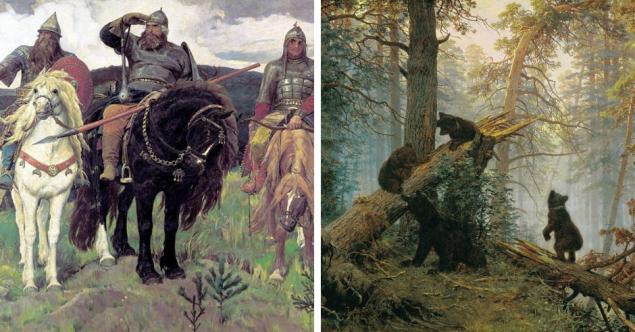631
The five secrets of the most mysterious paintings of the Tretyakov gallery

To understand art is not as difficult as it seems. It's not necessary to learn a few years on art. It is enough to communicate with experts who will tell you about the famous paintings so that then in the Museum you can see them from an unexpected quarter. Lecturer of the educational project for Level One, certified art historian Natalia Ignatova revealed the secrets of five of the most enigmatic paintings of the Tretyakov gallery.
The website publishes this stunning material to your reader.
"Heroes," Viktor Vasnetsov, 1898

The picture with the three heroes fairy tales Victor Vasnetsov has devoted a significant part of his life. The painting is one of the Champions of the Tretyakov gallery by the number of years spent on its creation. First sketch the artist made in 1871, and finished his masterpiece only in 1898-M.
Contrary to popular opinion that the knights went into the field just to walk around and observe the surroundings, they are ready to rush into battle. The enemy is in the distance, as if behind the audience, its presence is evidenced by the gathering clouds, the hawks are looking forward to prey, but the extended sword Dobrynya Nikitich and ready to fire a bow in the hands of Alyosha Popovich.
The prototype Ilya Muromets became the Emperor Alexander III, Dobrynya Nikitich, the artist wrote to himself, but the prototype of Alyosha Popovich is not known, they could be commoner — Vasnetsov in the process of working on a painting painted many portraits of peasants, coachmen and blacksmiths, which he thought was something similar to the famous fairy-tale characters.
"The unequal marriage", Vasili Pukirev, 1862

The plot for the film was prompted by Vasily Pukirev his friend, the artist Shmelkov Peter. He well knew the manners of wealthy and influential people for whom arranged marriages were commonplace. Pukirev thanked the man for the idea, portraying him right behind the bride. Present in the picture and the painter: he wrote himself into a profile image of the best man bride with her arms crossed. Initially, the artist didn't plan to put yourself on the canvas: in his place was the man whose sweetheart married an older. And each Pukirev due to family circumstances was forced to attend that unpleasant the wedding as best man.
Subsequently, the man asked the artist to remove it from the plate to friends and relatives remembered once again the story. Then Pukirev wrote itself instead. If you visually divide the canvas diagonally from upper right to lower left, then the right side will be the bride and two of her friends. While located on the left relatives and friends of the groom, deliberately depicts unpleasant people. Thus, the canvas is divided into two parts, as if personifying good and evil. And the priest is on the side of evil. This appointment demonstrates the commitment of the artist, principles of realism, thus it raises the question of the role of the Church in society.
"Morning in a pine forest, Ivan Shishkin, Konstantin Savitsky, 1889

Not all sweets lovers know that on the famous painting, which was then replicated on the wrappers of chocolates, were two of the artist. Shishkin was responsible for the forest, and Sawicki for the bears. Moreover, the plot coined by Sawicki. The bears originally had two, but then their number increased. Collector Pavel Tretyakov acquired the painting for 4 thousand rubles.
However, it is believed that the collector did not like the work of Savitsky. According to legend, Tretyakov said, "What kind of bears are scary!" And last name Savitsky on the canvas was smeared according to one version, this was done Tretyakov, and on the other — the artist, who offended, do not endure criticism from the gallery. Skill Shishkin expressed in the lighting of the forest: on the tops of the pine trees expertly written by the first rays of the sun, which the audience usually does not notice, distracted by the figures of bears.
"The appearance of Christ to the people Alexander Ivanov 1857
The first meaningful picture on the biblical story of Alexander Ivanov wrote in 1834. It was the appearance of the resurrected Christ to Mary Magdalene". And three years later, in 1837, he started creating the main work of his life — an epochal canvas the appearance of Christ to the people". The artist worked on the painting for 20 years in Italy. In the process of creating the paintings he made over 500 sketches and sketches. That Ivanov is working on a monumental canvas, was known to all the connoisseurs of art in Russia. In may 1858, the painter decided to send a picture in Saint Petersburg. According to legend, during the trip the ship was overtaken by a violent storm. The artist turned the canvas into the pipe and raised over the head — he chose not to see the destruction of their creation, and drown himself, if this ship goes under the water.
However, the painting arrived in St. Petersburg, where it was exhibited in one of the halls of the Academy of arts. The public picture took cold — had a claim and too little figure of Christ, and to water, is depicted not in an academic manner, and free strokes. Curiously, Ivanov in this sense was ahead of its time, because later in a similar manner will work the Impressionists. In addition, the painting was incomplete. In the left part you can see the old man in the white loincloth, which is reflected in the water of red. On thumbnails the dressing was really red, and the artist, apparently, just forgot to repaint. A month after the presentation of the work Ivanov died a few hours after his death, the Emperor Alexander II purchased the painting for 15 000 rubles. Despite the fact that the amount was substantial, initially, the artist dedicated this work half life, hoped for a much higher fee, but, unfortunately, did not receive even the money.
"Moscow courtyard", Vasily Polenov, 1878

The picture of itinerant Vasily Polenov is closely linked to another of his work titled "grandmother's garden". Both paintings depict the same house in the Arbat district, just from different sides. Polenov wrote his most famous work, he moved to Moscow from St. Petersburg and settled in an apartment house at the intersection of Durnovskaya and Trubnikovskii of the side streets near the Church of the Savior on the Sands.
Shown in the picture the view was. Moreover, the creation of a masterpiece Polenov took quite a bit of time: in fact, this is a study painted from life. For the first time in the history of Russian painting, the artist has combined the two genres — household and landscape. The public, tired of the gloomy and depressing paintings of the Wanderers, took a cheerful Sunny painting with enthusiasm. No one was even embarrassed by the garbage depicted in the lower left corner that most viewers take for well.
via factroom.ru























